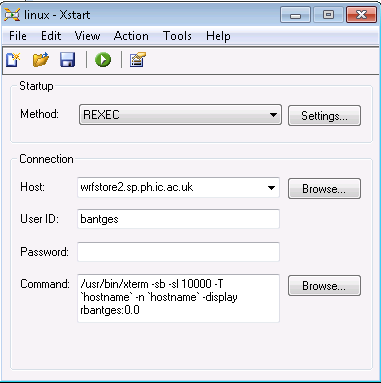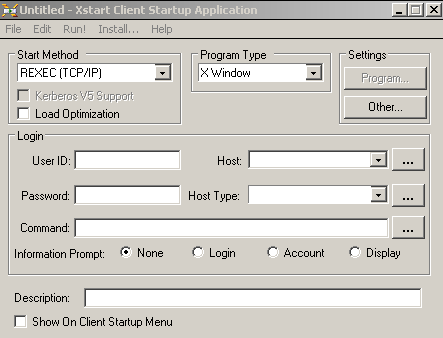![]()

Space & Atmospheric Physics
Group Specific Computing Information
Last updated: 10th October 2022
| Group computing home |
Hardware |
| RedHat Linux Servers |
| Printing & Photocopying |
Software |
| SPAT Specifc Software |
| Imperial Software |
| Free (GNU) Software |
FAQs |
| Getting help |
| Acessing Sun Workstations |
| Accessing Linux Servers |
| Linux filesystems /net/hostname |
| How much disk space am I using? |
| Setting up my personal webpage |
| Computing equipment purchase |
| Computing equipment disposal |
SITE INFO |
You are in: Accessing Linux Workstations
To access the Linux Servers from a computer running either Linux or MAC OS, you should be able to simply connect using SSH (SSH v2 is the preferred protocol).
Important: Please check which Linux Servers you are allowed to access here.
For those wishing to access the Linux Servers remotely via a PC running a Windows operating system, you will require additional software:
- for full functionality you will require OpenText eXceed software or the free Xming X server software AND Putty
- if you just wish to run software via the command line (.e.g. IDL rather than IDLDE) then you may use an SSH client e.g. Putty
- for transferring files between the Linux Servers and your Windows PC, you should use the free WinSCP software
Accessing from outside of Imperial College - you cannot access these servers directly from outside of Imperial College, you will first need to connect to the College VPN server (with the exception of spat-nas.sp.ph.ic.ac.uk which has been enabled as an externally visible SSH server).
New: The preferred method to connect to our Linux Servers
Owing to potential security issues associated with accessing the Linux servers using Xstart clients (as described later), I am slowly phasing out its use. The preferred method is to use a secure protocol, such as SSH to connect. The following information describes how you should use Putty in combination with eXceed to access and work on our Linux servers.
1. Once you have Putty installed, you should set the following options:
- complete the "Host Name (or IP address)" field - with the name of the computer you want you connect to
- make sure that you are connecting using SSH and the Port is set to 22
- next, navigate to Connection -> SSH -> X11
- click to "Enable X11 forwarding" and type the name of your Windows PC in the "X display location"
- note: you made need to specify the full pc name: e.g. my_pc_name.sp.ph.ic.ac.uk:0.0 (this will depend on how your pc's networking is configured
- now you should navigate back to "Session" as seen in the first Putty image above.
- type the name of the Linux server you're connecting to in the "Saved Sessions" box and click save
Now your Putty session should be correctly configured. However, before doing anything else, you need to make sure that you have an X Windows emulator running - either Exceed or Xming.
- if you haven't already been running eXceed, you'll have to start it by clicking on the Windows Start Menu and locating the Open Text Exceed installation on your PC.
Once Exceed is running, you are ready to connect to the Linux server of your choice using the connection you've just configured in Putty. Double click on the saved session referring to the Linux server you wish to connect to (e.g. spat-nas is highlighted in blue in the top Putty image).
A window should appear and you will be able to log in using your Imperial College username and password.
TIP: If you are unhappy with the colour setup of the window, you can customise the colours in the "Window -> Colours" section of Putty. Remember to save your session once you've made the colour changes however. Also, the colour changes will only apply to an individual session.
(NB: R:255, G:255, B:255 will be white, R:0, G:0: B:0 will be black).
TIP: When you connect to the Linux servers using Putty, if you wish you have various system variables and paths automatically defined each time to log in (equivalent to the .cshrc file in SOLARIS), then you should put those path and variable definitions in /home/username/.bashrc (have a look at /home/bantges/.bashrc for an example).
- To make sure the contents of your .bashrc file are run each time you log in, you also need to create a file in /home/username/ called .bash_profile
- The contents of .bash_profile should be a single line that contains the following:
source .bashrc
DO NOT INCLUDE THIS LINE
but for clarity: the line above reads: "source <space> .bashrc"
TIP: Remember, filenames that start with a full-stop (dot) are hidden if you do a normal list (i.e. ls). You should type: ls -Fla to enable all files in a directory to be returned from the list command.
(Insecure method described below which will be phased out and will not work for connections to wrfstore3 and wrfstore4)
Configuration of the OpenText eXceed software
Using the eXceed software, you need to locate the program "Xstart" from the Windows Start Menu (possibly in Start-> Programs - > OpenText -> Exceed -> Exceed Tools -> Xstart").

An example of what to enter in the fields is contained in the image above. However, a brief explanation is provided below:
Host: wrfstore2.sp.ph.ic.ac.uk (access to eos.sp.ph.ic.ac.uk is prohibited as it's the main server)
User ID: your_imperial_college_username
Password: Leave blank (you will be prompted to enter your password when you connect)
Command: /usr/bin/xterm -sb -sl 10000 -T `hostname` -n `hostname` -display mycomputer:0.0
Note (1) -sb -sl 10000 will provide an xterm with a scroll bar (sb), with scroll length (sl) 10000 lines
Note (2) there is a space between -T and `hostname`, -n and `hostname`
Note (3) the appostrophy is ` and not '
Note (4) "rbantges" - enter the name of your computer here e.g. spatpc.sp.ph.ic.ac.uk
Note (5) The command for linux servers is subtly different than for the Suns
Now save this file to something like linux.xs on your desktop for example. This will mean you just have to double click the linux.xs icon on your desktop and enter your password when you want to connect to one of the servers.
Older versions of eXceed may present the following screen instead of the one above:
Using the eXceed software, you need to locate the program "Xstart" from the Windows Start Menu (possibly in Start-> Programs - > OpenText -> Exceed -> Xstart").

Complete the fields using the following settings:
User ID: your_imperial_college_username
Host: iasi.sp.ph.ic.ac.uk (access to eos.sp.ph.ic.ac.uk is prohibited as it's the main server)
Host Type: UNIX
Command: /usr/bin/xterm -sb -T `hostname` -n `hostname` -display mycomputer:0.0
Note (1) there is a space between -T and `hostname`, -n and `hostname`
Note (2) the appostrophy is ` and not '
Note (3) mycomputer - enter the name of your computer here e.g. spatpc.sp.ph.ic.ac.uk
Information Prompt: Select "Login"
Now save the file: File -> Save As (best to save on your Desktop - name the file linux.xs)
Double click the "linux.xs" shortcut on your desktop and enter your Imperial College password.